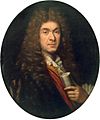Baroque music facts for kids

Baroque music is a style of classical music. It was popular in Europe from about 1600 to 1750.
The word "Baroque" is also used for other art forms. You might hear about Baroque architecture, painting, sculpture, dance, or literature. This period came after the Renaissance and before the Classical period in music.
Contents
What is Baroque Music?
When Did It Start?
Musicians usually say the Baroque period began around 1600. Famous Renaissance composers like Palestrina and Lassus had died a few years earlier. Claudio Monteverdi wrote music that mixed old Renaissance styles with new Baroque ideas. This was also when opera was first invented. It was a time of big changes in music!
When Did It End?
The change from Baroque to Classical music was slow. But 1750 is an easy date to remember. That's because it's the year Bach died. He was one of the most important Baroque composers.
Baroque Style in Art and Music
The Baroque era loved grand spaces and lots of decoration. You can see this in buildings like St. Peter's Basilica in Rome. Or look at St. Paul’s Cathedral in London. Both were built during this time.
In Venice, some churches had balconies on opposite sides. Composers like Giovanni Gabrieli wrote music for two groups of musicians. They would play from these different balconies. This created a cool "stereo" effect.
Sounds and Instruments
Contrasting Sounds
Baroque music often used the idea of two different groups playing together. Composers wrote concertos. These pieces featured a solo instrument playing with an orchestra. Sometimes, a concerto would have a small group of soloists. This group would play against the rest of the orchestra. These pieces are called "Concerti Grossi". Bach's Brandenburg Concertos are great examples.
Organs and some harpsichords from this time had two or more keyboards. Players could switch between them. This let them create different sounds and contrasts.
Melody and Bass Line
Baroque music often had a clear melody on top. And it had a strong bass line at the bottom. Imagine a singer with a cello playing the bass. A harpsichord or organ would also play the bass line. Plus, it would fill in the chords in the middle.
Sometimes, composers didn't write out every single note for the chords. They just used numbers to show the basic chords. This was called "figured bass" or "basso continuo". The musician playing the harpsichord or organ would then improvise the rest. Also, soloists often added their own fancy notes. Composers usually let them improvise these extra decorations.
Polyphony vs. Opera
In the Renaissance, choirs often sang many different melodies at once. Each part might even have different words. This style was called "polyphony". It was common in instrumental music too.
But when opera started, it was important to hear the words clearly. Opera needed to tell a story. So, polyphony was not used as much in opera. It could make the story confusing.
Musical Moods
In Baroque opera, each song (called an aria) had a specific mood. They called this an "affection." There were arias for revenge, jealousy, anger, love, or peaceful happiness. Each part of a concerto also had its own special mood.
Music from later periods is different. For example, in the Classical period, composers like Haydn would often change the mood many times within one piece.
Baroque Suites
A Baroque suite is a collection of dance movements. These are all written in the Baroque style. There's a common order for these dances.
The five main dances are the Overture, Allemande, Courante, Sarabande, and Gigue. Often, a composer would add a Prelude before all the dances. Sometimes, another piece might be added between the Sarabande and the Gigue.
The most common order is Prelude, Allemande, Courante, Sarabande, Other, and Gigue. You can remember this with the acronym PACSOG.
Famous Baroque Composers
Here are some of the most important composers from the Baroque period:
- From Italy
- Giovanni Gabrieli (around 1553-1612)
- Claudio Monteverdi (1567-1643)
- Arcangelo Corelli (1653-1713)
- Antonio Vivaldi (1678-1741)
- Domenico Scarlatti (1685-1757)
- From Germany
- Heinrich Schütz (1585-1672)
- Johann Sebastian Bach (1685-1750)
- From England
- Henry Purcell (1659-1695)
- George Frideric Handel (1685-1759) (He was born in Germany but lived in England)
- From France
- François Couperin (1668-1733)
- Jean-Philippe Rameau (1683-1764)
Images for kids
-
Painting by Evaristo Baschenis showing Baroque instruments. These include a cittern, cello, violin, and two lutes.
-
Johann Sebastian Bach, 1748
-
Claudio Monteverdi in 1640
-
Jean-Baptiste Lully by Paul Mignard
-
A double-manual harpsichord by Vital Julian Frey.
See also
 In Spanish: Música del Barroco para niños
In Spanish: Música del Barroco para niños









